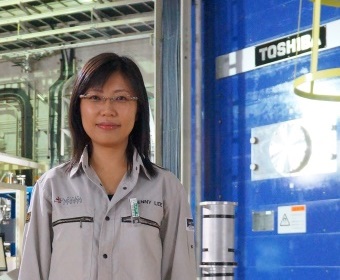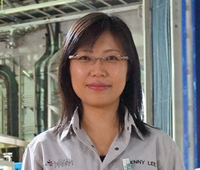Jun. 28, 2013
Understanding the Universe
Jenny Lee, Researcher
What led you join RIKEN?
When I was a graduate student at the National Superconducting Cyclotron Laboratory in the United States, my thesis advisor encouraged me to pursue research at RIKEN, describing its nuclear physics facilities as some of the most advanced in the world. I seized the opportunity to work here and when I arrived, I found that the facilities exceeded my expectations.
Please tell us about the aims of your center.
I am studying nuclear structure using the RIKEN Nishina Center for Accelerator-Based Science’s radioactive-isotope beam facility, the Radioactive Isotope Beam Factory. The goal of our research is to try to understand the origins of the Universe—to unlock the secrets of how the Universe, and everything in it, is put together, beginning at the level of the nucleus.
Please tell us more about your work at RIKEN.
 © 2013 RIKEN
© 2013 RIKEN
We mainly study exotic nuclei using the radioactive-isotope beams. The nucleus is composed of protons and neutrons, and to understand how they are put together, we disturb them by means of nuclear reactions and detect the reaction products using our detectors.
Nuclei can exist in certain configurations, and it turns out that adding just a single neutron or proton, for example, can cause the nucleus to take on a completely different shape with very different properties. By studying the structure of a particular nucleus, we can use the information to investigate nucleosynthesis—how the elements of the Universe were created.
What are your goals while at RIKEN?
As a junior scientist, I am still digesting the bigger picture so that I can create my own theories and research agenda. In the future, I would love to help establish nuclear physics as a field of research in Hong Kong, where I come from. There is no infrastructure there yet, so someday I hope to return to share the knowledge and experience that I have gained at RIKEN. I think it would be challenging, but meaningful, to start something new.
What has surprised you about working at RIKEN?
When I was an undergraduate student in Hong Kong and then studying for my PhD in the United States, people tended to go home right after work. But at the Nishina Center, colleagues often get together after work to socialize and talk about things, and RIKEN holds a number of parties and festivals on its campuses. It is part of an interesting working philosophy.
What advice would you give to other young scientists considering working at RIKEN?
RIKEN has a very open environment, where even young scientists are encouraged to discuss ideas and hypotheses. In the United States, there is a tendency for the number of papers to be very important—everything is about results—whereas here people encourage discussion on ‘real physics’ and concentrate on how they can perform elegant science. Of course, publishing papers is still important, but there is more of a focus on thinking and more of an emphasis on interaction.

